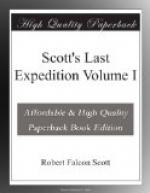Before the ship left dock, Bowers and Wyatt were at work again in the shed with a party of stevedores, sorting and relisting the shore party stores. Everything seems to have gone without a hitch. The various gifts and purchases made in New Zealand were collected—butter, cheese, bacon, hams, some preserved meats, tongues.
Meanwhile the huts were erected on the waste ground beyond the harbour works. Everything was overhauled, sorted, and marked afresh to prevent difficulty in the South. Davies, our excellent carpenter, Forde, Abbott, and Keohane were employed in this work. The large green tent was put up and proper supports made for it.
When the ship came out of dock she presented a scene of great industry. Officers and men of the ship, with a party of stevedores, were busy storing the holds. Miller’s men were building horse stalls, caulking the decks, resecuring the deckhouses, putting in bolts and various small fittings. The engine-room staff and Anderson’s people on the engines; scientists were stowing their laboratories; the cook refitting his galley, and so forth—not a single spot but had its band of workers.
We prepared to start our stowage much as follows: The main hold contains all the shore party provisions and part of the huts; above this on the main deck is packed in wonderfully close fashion the remainder of the wood of the huts, the sledges, and travelling equipment, and the larger instruments and machines to be employed by the scientific people; this encroaches far on the men’s space, but the extent has been determined by their own wish; they have requested, through Evans, that they should not be considered: they were prepared to pig it anyhow, and a few cubic feet of space didn’t matter—such is their spirit.
The men’s space, such as it is, therefore, extends from the fore hatch to the stem on the main deck.
Under the forecastle are stalls for fifteen ponies, the maximum the space would hold; the narrow irregular space in front is packed tight with fodder.
Immediately behind the forecastle bulkhead is the small booby hatch, the only entrance to the men’s mess deck in bad weather. Next comes the foremast, and between that and the fore hatch the galley and winch; on the port side of the fore hatch are stalls for four ponies—a very stout wooden structure.
Abaft the fore hatch is the ice-house. We managed to get 3 tons of ice, 162 carcases of mutton, and three carcases of beef, besides some boxes of sweetbreads and kidneys, into this space. The carcases are stowed in tiers with wooden battens between the tiers—it looks a triumph of orderly stowage, and I have great hope that it will ensure fresh mutton throughout our winter.
On either side of the main hatch and close up to the ice-house are two out of our three motor sledges; the third rests across the break of the poop in a space formerly occupied by a winch.
In front of the break of the poop is a stack of petrol cases; a further stack surmounted with bales of fodder stands between the main hatch and the mainmast, and cases of petrol, paraffin, and alcohol, arranged along either gangway.




